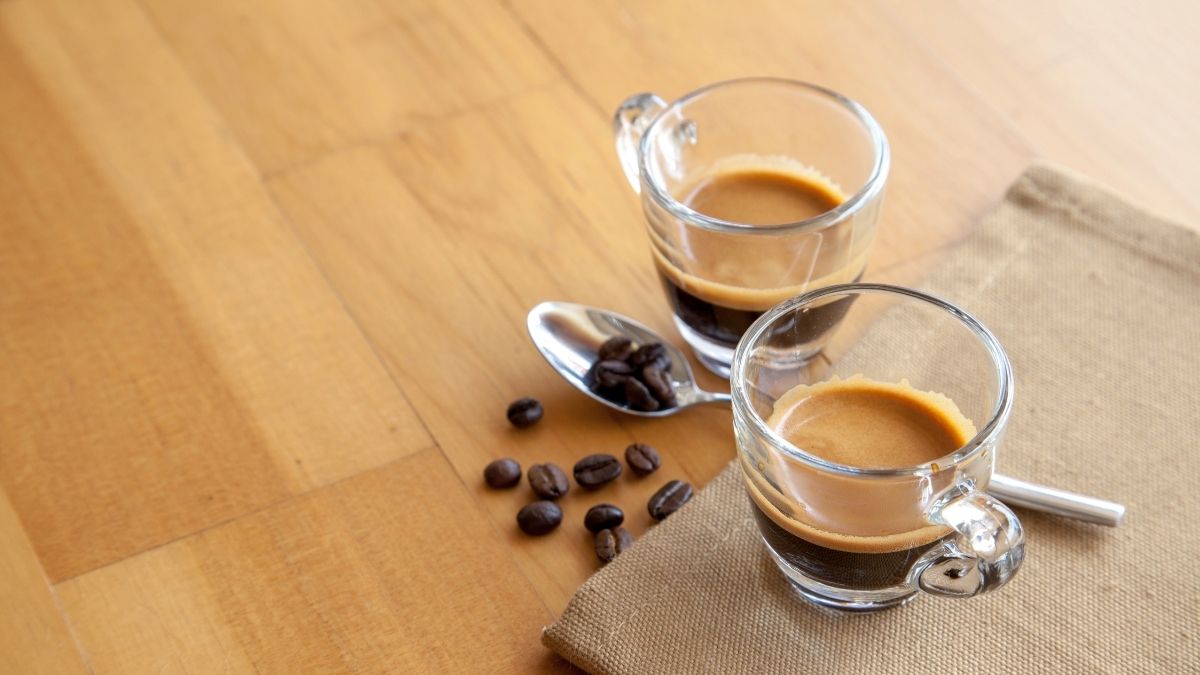Espresso is a highly concentrated form of coffee that is produced by forcing hot water through fine grounds via the high-pressure mechanism of an espresso machine. It’s commonly believed that espresso has higher amounts of caffeine than regular coffee, and that’s true if both of them would be served in one-ounce shots, but also false because an eight-ounce cup of hot coffee contains more caffeine than a shot of espresso.
It’s also a common occurrence that some people tend to feel more comfortable sipping an espresso shot or an espresso-infused beverage than normal coffee, either drip or poured. This may be due to the acidity of each one.
Generally, espresso is less acidic than drip coffee but more acidic than cold brew. Acidity in coffee is an ambiguity that may refer to its taste or pH level, but they are not related at all with the pH value almost entirely negligible.
Coffee origins and preparation, brewing time, extraction methods, water temperature, and serving are all contributors to the resulting acidity of coffee, and the acidic quality of a blend isn’t a worrisome factor but rather a desirable effect that defines the uniqueness of a type of coffee. The science behind coffee acidity, its effects, and the types that would suit your preference are a few notes that would be generously expressed in this article.
Espresso Acidity
To best understand where this is going, I’d like to refer to this article to make a clear distinction between coffee acidity and pH levels. First, hot coffee, espresso, and cold brew have very closely related pH values, ranging between 4.85 to 5.13, which makes all of them relatively weak acidic beverages (orange juice has a pH of 3.3 to 4.2).
However, where this three get separated is the “acidity” of each kind. Acidity in coffee terms refers to the sharpness, astringency, tartness, and fruity notes of a blend, as well as the edgy feel along the lips and tongue, and finally the stingy dryness behind the throat, but it’s not directly related to the pH of the drink. Rather, they’re related to the rate of extractions of acidic compounds per type.
Acidity is poorly measured by pH values due to the lack of correlation of pH level and rate of extracted acidic compounds in coffee drinks which is why it’s measured via concentration in milligrams per liter. Simply put, the higher the concentration of acidic compounds found in coffee, the more acidic taste it would have but not necessarily be lower in pH.
This is why brewing, extraction, and temperature are the major factors affecting the acidity of coffee, but it’s not limited to those. Other factors can be considered.
Origins
The coffee bean origins play a relatively small part in the acidity of common espresso and coffee because most espresso blends use the same beans as do traditional drips, but what sets their acidity and caffeine content apart is merely the mix of the beans.
Regardless, the main deal to know about coffee origins is that variants grown in higher elevations tend to be more acidic such as the most widely-used Arabica coffee which is grown in elevations no less than 2,000 feet (600 meters) above sea level and most common in the high altitudes of Africa and Latin America. While variants raised in lower elevations are less acidic such as the Robusta coffee which is more widely produced in the low-lying regions of Africa.
Espresso blends are usually made with Arabica but are also mixed with Robusta which contains about twice the caffeine of the former, a more bitter and better crema, and a smoother mouthfeel. So, since espresso is a mixture of high and low acid blends, this is one factor that makes it less acidic than the common 100% Arabica brews.
Roast
The degree of roast also affects the acidity of a blend such as the longer and darker the beans are roasted, the less and less acidic they become due to the breaking down of chlorogenic acids into caffeic and quinic acids which are slightly bitter.
Caffeic acid is unrelated to caffeine, but they share similar effects such as boosting athletic performance and helping prevent cancer and diabetes. This acid also seems to be present wherever caffeine is like in coffee, tea, and plant-based foods. More specified info from Healthline.
Quinic acid is used as an astringent and is also a basic ingredient in the synthesis of Oseltamivir, a drug treatment for influenza A and B.
Chlorogenic acids and their products are all relatively weak acids, so their pH levels aren’t very significant, but chlorogenic acids usually introduce the sharp tartness in coffee and they are beneficial compounds too. In espresso, there are fewer of these flavors which make it taste less acidic and more bittersweet than standard coffee which is a light to medium roast.
Light roast espressos do exist, but they have a fruitier and sharper complexion than the normal dark roast ones.
Grounds
The size of the coffee ground will also determine the resulting acidity of the blend. Espresso tends to be finer than coarse ground coffee, but not all the time since Turkish coffee has finer grounds than espresso. Usually, finely ground coffee has greater surface exposure per particle than course ground, therefore they’re more susceptible to releasing their acids, resulting in a more tart blend. However, espresso is dark roast so much fewer acids to excrete and more oils to cover up.
Brewing
Espresso has the shortest brewing time of any coffee, with only 20-30 seconds per shot. Naturally, the shorter the brewing time, the more acidic the blend tends to be, but since espresso is shot through with pressurized hot water unlike the drips and pours, there’s barely enough window for the acidic compounds of the grounds to seep through.
Also, since espresso commonly uses darker roast which is already robbed of most of its acids, the oils, sugars, and proteins take over and are responsible for the three components of espresso: the heart, the body, and especially the crema. The crema is the natural culmination of emulsified oils and gaseous compounds that give the distinct, frothy, and desirably bitter taste of espresso, while the body and heart balance the entire blend with sweet and fruity notes.
Extraction
Usually, a shorter extraction period results in a more acidic coffee, but since again, espresso uses dark roasts nearly void of acidic flavors and doesn’t go through a paper filter which may intercept the proper extraction of vital oils during the process, an espresso machine produces a blend of sweet and bitter tastes.
An espresso then becomes less acidic than drip coffee because of the latter’s paper filter that holds the oils and allows more acids to pass through from the lighter roast.
Temperature
What sets cold brew apart from regular coffee and espresso shots is of course the temperature by which it’s processed. Cold brews take the longest extraction times of all coffee ranging from 12-18 hours at length. Most oils and acids do not extract in cold temperatures (below 20 °C) and so the bitter and tart tastes that espresso and coffee would usually have are eliminated in cold brews, leaving only a sweet and smooth flavor that almost has no aroma nor the common complexities of regular coffee.
Cold brews retain beneficial qualities similar to espresso such as the rich antioxidants, high caffeine content, and is the least acidic coffee type.
Serving
The way a blend is served also affects the acidity of coffee. For example, more water poured through a light roast coffee would result in a lesser, almost bland, acidity, and the same goes for lungo espresso which contains less caffeine and a milder taste than a solo shot.
Milk, which has a pH level of around 6.4 to 6.9, is one of the weakest acidic beverages and when added to coffee, entirely makes the blend less acidic in taste. According to Food Faq, this would slightly lower the pH level of your coffee though, since milk is acid-forming. So this phenomenon already shows you an example that pH level does not affect the acidic taste in beverages like coffee and vice versa.
Causes Of Heartburn, Acid Reflux, And Indigestion
Drinking coffee is known to have mild side effects in some people such as the ones stated above, but besides the natural acidity and pH values of coffee, you’d be surprised to find the real culprits of these uncomfortable occurrences when drinking your morning cup.
Your Sensitivity
Some people get very uncomfortable bowel movements from a single cup of coffee, while others don’t feel a thing even after their fourth cup. This is because not everyone’s tolerance and sensitivity to coffee are the same. Naturally, coffee veterans have more immunity to the effects of coffee, but even non-coffee drinkers may not feel affected when taking a cup due to their innate tolerance.
Your Diet
You are what you eat, and if you eat highly acidic foods all the time like citrus fruits, milk, and junk, then chances are you’d be more susceptible to the acidifying effects of coffee. Learn to balance your meals with enough proteins and carbs to absorb the acidic compounds of your coffee beverage.
Your Life Style
A healthy and well-balanced lifestyle with good food and sweet rest is a very important factor in overall well-being, and not only that, but smoking, excessive alcoholism, and drug abuse are also common perpetrators of a highly acidic system that is easily triggered by caffeinated or other acidic beverages like coffee.
Coffee indeed induces heartburns and gastroesophageal reflux more commonly known as GERD. If you have this sort of disease that causes stomach acids to flow back up your throat, then opt for cold brew otherwise test your tolerance with other coffee and espresso.
There’s no solid evidence that either caffeine or the acidic components of coffee are the main culprits for GERD irritation, and there’s no absolute cure or remedy either. All that can be done is to regulate the intake of acidic and caffeinated beverages and food.
Dyspepsia, or indigestion, is also a reported side effect in some people after drinking coffee, but it’s been proven that it has nothing to do with coffee and is more of a result of ineffective eating habits, wrong diets, chemical abuses, or just a person’s intolerance.
Bottom Line
Espresso shots are generally less acidic than your average coffee cup and have great health benefits that could improve your overall well-being if taken in moderation, which is about 4 to 5 shots a day. It’s more acidic than cold brew, which is why if you suffer from mild to severe heartburns then you should opt for less espresso and more cold brew instead.
Generally, if you prefer low-acid profiles then you should look for darker roast coffee with course grounds and longer brewing and extraction periods. Try avoiding adding acidic sweeteners to your coffee as well as milk and sugar which although may introduce sweeter and milder tastes, actually add to the acidic compounds and sometimes the pH values of your drink.
If you like coffee with sharper and more complex flavors, then high-acid profiles may suit you such as light roast Arabica variants. Those coffee beans with harder and lighter composures. The hotter and more aromatic beverages with kicks would suit you better this way.
Finally, don’t fret too much about the possible side effects of drinking coffee as these symptoms mostly depend on what you already have and you may have just drunk your cup at the wrong time. Equally, drinking coffee as water wouldn’t be healthy either since high concentrations of caffeine aren’t exactly beneficial as it postpones the natural functions of your body such as sleepiness and relaxation. Those are important aspects of our lives too.
Well, that’s it for this article and I better get myself a great cup of coffee too.


